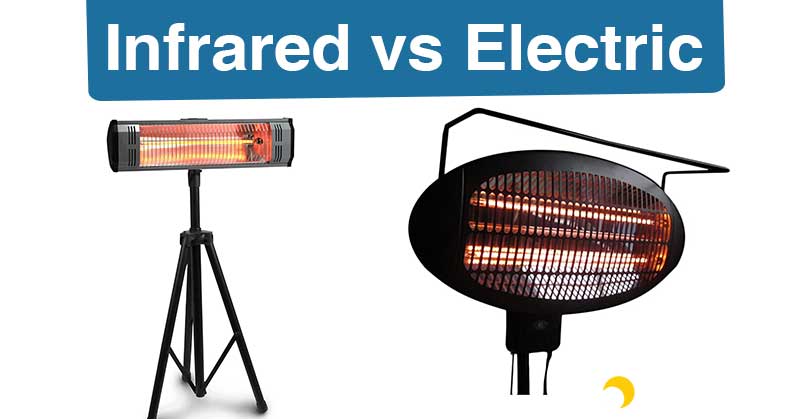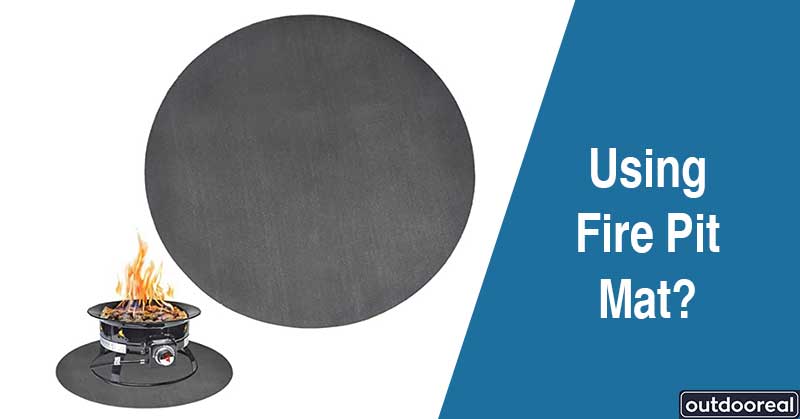An infrared heater can be powered by electricity, propane, or natural gas, which makes an infrared heater also an electric heater if it’s run by electricity. The heating mechanism creates the difference between infrared heaters and traditional electric heaters. Comparing most of the user aspects infrared patio heater is better than an electric one; however, due to some disadvantages, an electric patio heater can be a good choice over an infrared type.
In our previous article, we discussed the differences between gas and electric patio heater. It’s time to discuss about infrared vs electric outdoor heater.

Here are the differences and performances on various factors of infrared and electric patio heaters:
Topic | Infrared patio heater | Electric patio heater |
Heating method | Radiant Heating | Convection heating |
Safety | Comparatively safe | Safest |
Types | Infrared heaters can be: Propane/gas-powered or electricity powered | Electric heaters can be: Battery run type or constant electricity plug-in type |
Portability | Excellent portability | Battery types are portable only |
Ease of use | Electricity-powered ones are only easy to use. | Very easy to use |
Maintenance | Propane or gas ones are a little bit difficult to maintain | Very easy to maintain |
Operation cost | Cheaper than traditional electric heating | More costly than infrared heaters |
Product price | Affordable | Affordable |
Longevity | 10-15 years | 10-25 years |
Heat Output | Propane or gas will have more heat output | Lesser heat output |
Differences in Details:
Heating method:
An infrared heater uses radiant heating. Infrared radiant heat is like how the sun makes you feel when it heats you.
When a material is heated to a certain point, it gives off heat in the form of radiant heat. The heater then sends out heat in the form of electromagnetic waves. In this way, heat spreads out evenly over a large area. In this system, the heat is also pushed into the air. People often choose an infrared space heater because they like how radiant heat makes them feel. At the same time, an electric heater uses convection heating. In this method, electricity flows through a resistor or something else that blocks an electric current. In the end, it is turned into heat energy and moved around the space.
Safety:
The electric patio heater is undoubtedly safe and will not cause direct ember flying or fire catching. While infrared patio heaters may have different types, propane or gas patio heater is comparatively less safe than electric heaters. Nevertheless, it is also the safest option for an electric infrared patio heater.
In the end, safety does not depend on the method the heater use; rather, it depends on the type of fuel it uses. For gas or propane patio heaters, you will always have to maintain some extra safety precautions than the electric ones. However, it is up to you how you use the product, and if you take steps and measurements according to the product, you’ll enjoy any patio heater safely and soundly.
Types:
Based on fuel, the primary type of infrared patio heater will be propane, gas, and electricity. If it is only an electric heater, it may run by a rechargeable heater or need a constant electricity plug-in.
Propane or gas infrareds are standing or table-top designs other than the fuel type. An electric infrared or patio heater will be wall-mounted, sitting, standing, table-top, or even a hanging lamp. As patio heaters are designed for patios and gas or propane heaters can not be used indoors, or under a covered porch, their design is compatible outdoors.
On the other hand, electric patio heaters can be used under a gazebo or even under a covered porch. This is why the designs are suitable for different locations.
Portability:
The infrared propane heater is the best at portability, while electric patio heaters need a constant connection for fuel. You can take the propane patio heater anywhere, even in the camps; if you have a gas tank, it will run anywhere. However, you will only get a socket in some places, and this is where the electric patio loses portability. A rechargeable electric patio heater is an exception; you take it anywhere. As long as it is charged, it will work.
Ease of Use:
Ease of usage depends on how the product is manufactured and your understanding. But from a broad perspective, propane or gas patio heater is challenging due to their complex mechanism and fuel connection.
In contrast, electric infrared or electric patio heaters are the easiest ones to use. First, plug in the heater and use a remote control or switch to operate it.
Maintenance:
Again, the propane and gas patio heater falls in the problematic category of keeping. Gas patio heaters are hard to clean due to the regulator, pipe, hose, fuel connection, burner, etc. Assembling the parts is also tricky, as they have a complex build-up.
On the other hand, an electric patio heater has a simple build-up with the lamp and body to clean. Assembling is also easier for an electric or infrared electric patio heater.
Operation Cost:
Electric patio heaters are often considered the most money-saving option for the backyard. However, infrared heating is the most efficient burning and ensures low operation costs. In addition, infrared burning produces no waste; the fuel or power is used efficiently with the infrared system. Therefore, considering an electric heater’s substantial electricity bills or fuel costs, it is better to go for an infrared heater.
Product Price:
Electric patio heaters are the market’s most affordable and cheaper option.
On the other hand, propane or gas infrared patio heaters can be affordable to expensive. Usually, gas runs fire features are always a bit pricey compared to other alternatives. On the other hand, electric infrared patio heaters are also cheap, and some may be expensive.
Longevity:
How you use and maintain your product will define the product’s life span. For example, with satisfactory maintenance and care, the infrared patio heater will last 10-15 years if it is a propane or gas-run infrared patio heater. At the same time, an electric infrared or simple electric patio heater will last for 10-25 years.
Heat Output:
One of the most vital factors you need to focus on when buying a heater for a patio is the heat output. An infrared propane or gas patio heater will provide an excellent heat output of up to 40000-50,000 BTU, which is ideal for 2-3 people in the backyard and is also best for chilly areas and freezing climates. On the contrary, electric and infrared electric patio heater provides less heat output of around 1500-2000 watt, which may not be suitable for chilly weather.
Which One Should I Buy?
Selecting the best type of patio heater can be challenging for many, and when it comes to infrared or electric, it is very challenging to choose one. The first thing you should remember is the location you will be using the patio heater. If you are from freezing or chilly areas, it’s best to go for infrared propane or gas heaters. However, if you live in less cold regions, you can use an electric infrared patio heater for safety, longevity, cost, ease of use, and maintenance.
You should buy an infrared patio heater if;
- You are tensed about the electricity bills
- You can afford up to 200-300$ for a patio heater
- You care about efficient burning
- Radiant heating style is your comfort type.
You should go for an electric patio heater if;
- You love environmentally friendly products
- You do not live in a freezing area
- You have a tight budget
- Maintenance is a hassle for you.
Final Verdict
Finding the perfectly matched heater for your needs and home is essential. To accomplish that, consider your heating requirements, location, and personal preferences when deciding between electric heaters and infrared heaters. Also, consider the safety and future pros and cons you might face while using a specific patio heater.






